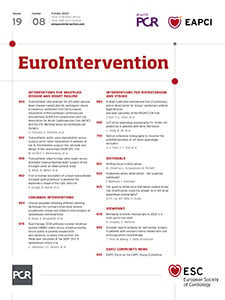The saga of bifurcation stenting strategies has entered a new chapter.
Recent findings question the provisional strategy (PS) as a first choice, supporting an upfront 2-stent (2S) deployment in complex true bifurcation lesions, notably for left main bifurcation disease1.
Several meta-analyses have been published comparing the PS to the 2S strategy, aiming to clarify findings from underpowered studies2. However, drawing accurate conclusions remains difficult. Various definitions and inclusion criteria for coronary bifurcation have been adopted, stent optimisation techniques (POT) and intravascular imaging have been heterogeneously used in randomised controlled trials (RCTs), newer-generation drug-eluting stents (DES) have been introduced over the years, and the selection, modulation, and duration of dual antiplatelet therapy (DAPT) have significantly evolved. All these variables strongly impact the prognosis and cannot be considered mere “confounding factors”.
The manuscript by Bujak et al in the present issue of EuroIntervention3 is a thoughtful, updated reply to the needs of interventional cardiologists. Overcoming the limitations of prior meta-analyses, this study adopts a more rigorous approach. The authors conducted a pairwise meta-analysis comparing the PS with the 2S strategy as well as a network meta-analysis (NMA) to evaluate all stenting strategies, focusing on major adverse cardiac events (MACE), a composite of cardiac death, myocardial infarction (MI), or target lesion revascularisation (TLR).
Overall, the PS and 2S strategy did not differ in terms of MACE, cardiac death, MI, TLR, or stent thrombosis (ST). A 2S strategy seemed appropriate when the side branch was not only an “innocent bystander” of main vessel disease but had developed a substantial lesion: the meta-regression showed a benefit of the 2S approach in terms of reduced MACE, MI, and TLR rates in RCTs enrolling patients with a side branch lesion length >11 mm.
The NMA highlighted the superiority of the double-kissing (DK)-crush technique in terms of MACE, TLR, MI, and ST, but, as commented by the authors, it’s crucial to contextualise such findings. Most data were derived from the DK-crush trials, where operators were confident with the technique, and patients allocated to the PS arm experienced an unacceptably high crossover rate to 2S (47% in the DKCRUSH-V trial)4. Such findings, aside from being cautiously interpreted, should instead support the concept that careful planning and limiting the liberal use of “bailout” stenting in coronary bifurcations are associated with a significant reduction of untoward midterm events5. Therefore, though the NMA may be a methodologically valid tool for comparison, it appears to create an uneven matchup between the two strategies.
Concerning procedural optimisation, a prespecified analysis showed no distinct advantage between the strategies when trials without proximal optimisation technique (POT) were excluded. The heterogeneous use of intravascular imaging in the RCTs precluded any evaluation. The European Trial on Optical Coherence Tomography Optimized Bifurcation Event Reduction (OCTOBER) recently showed a reduction of MACE associated with the use of intravascular imaging in complex bifurcations (19% left main), with an even more evident benefit in the PS group6. The use of intravascular imaging might also support a guided modulation of DAPT duration7, which is another relevant, but still unexplored, issue.
In conclusion, it seems that the longstanding question about which strategy is better is slowly becoming less crucial, in favour of new issues that concern how to best perform each strategy. In other words, “how to do” and “when to do” might be more compelling than “what to do”.
Conflict of interest statement
The authors have no conflicts of interest to declare.

